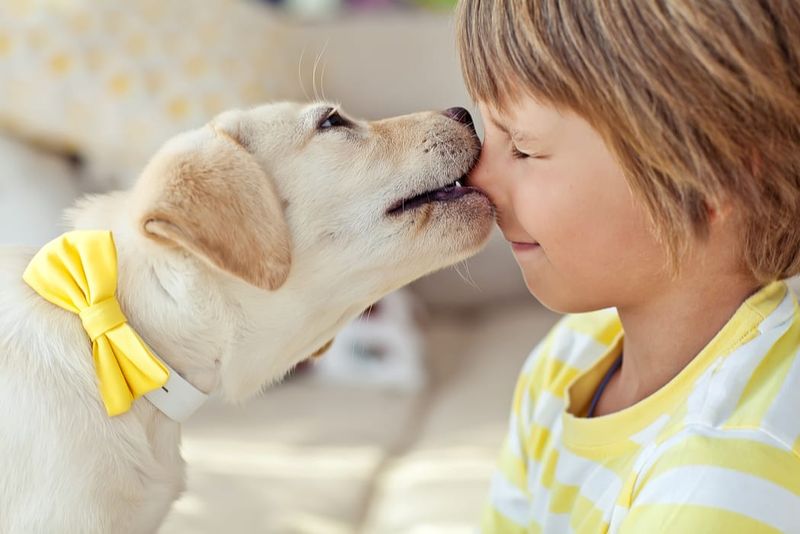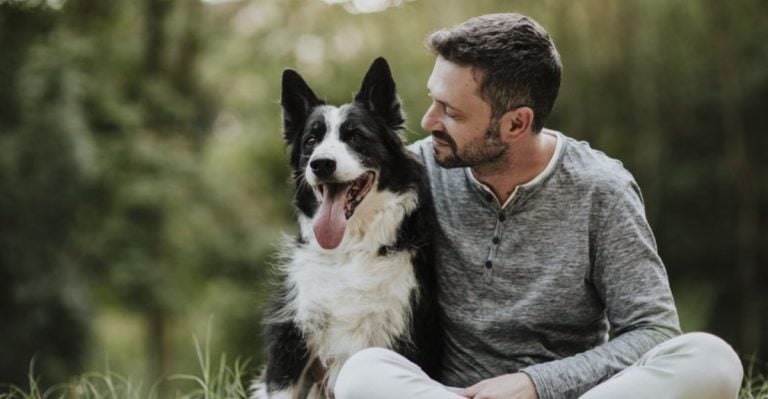Experts Say These 14 Dog Myths Are Flat-Out False
We’ve all heard plenty of ‘facts’ about dogs that get passed around like treats at a puppy party. From how they see the world to what that wagging tail really means, there’s a lot of misinformation out there.
Veterinarians and animal behaviorists have been working hard to debunk these common misconceptions that might affect how we care for our furry friends. Let’s set the record straight on some of the most persistent dog myths that science has proven wrong.
1. Dogs See Only in Black and White
Dogs actually see colors, just not the full spectrum humans do! They have two types of color receptors (compared to our three), allowing them to see blues and yellows but making reds and greens difficult to distinguish.
Research from the University of California shows canine vision resembles red-green colorblindness in humans. This explains why your pup might easily find a blue ball in green grass but struggle with a red one.
Next time you buy dog toys, consider blues and yellows—colors your furry friend can actually appreciate. Their world isn’t black and white, just differently colored than ours!
2. A Wagging Tail Always Signals Happiness
That wagging tail doesn’t automatically mean your dog is ready for cuddles! Tail wagging is simply a sign of emotional arousal, which could be excitement, anxiety, or even aggression.
Animal behaviorists point to the position and speed of the wag as crucial indicators. A high, stiff wag might signal alertness or potential aggression, while a low, relaxed sway typically means friendliness.
Right-sided wagging often connects to positive emotions, while left-sided wagging may indicate negative feelings. Always check your dog’s entire body language—ears, posture, facial expression—before assuming that wag means they’re happy to see you.
3. Dogs Age Seven Years for Every Human Year
The simple 1:7 ratio for dog aging is outdated science. Dogs mature much faster in their early years and then their aging process slows down. A one-year-old dog is closer to a teenage human than a seven-year-old child.
According to research published in Cell Systems, a more accurate formula shows dogs age about 15-20 human years in their first year, then aging slows considerably. Larger breeds typically age faster than smaller ones too.
Scientists now use DNA methylation patterns (how genes change with age) to track aging more accurately. Your 10-year-old Labrador isn’t necessarily 70 in human years—their age equivalent depends on their size and breed!
4. You Can’t Teach an Old Dog New Tricks
Senior dogs are perfectly capable learners! This harmful myth prevents many older dogs from being adopted and enjoying enriching training experiences. Contrary to popular belief, mature dogs often learn more efficiently than puppies due to their longer attention spans and established communication skills.
Veterinary behaviorists point out that older dogs might need slightly modified training approaches that account for physical limitations, but their cognitive abilities remain intact well into their senior years.
Many police and service dog organizations specifically select middle-aged dogs for training because of their focus and stability. Age isn’t the barrier—appropriate teaching methods and patience are what matter most.
5. Dogs Only Eat Grass When They’re Sick
Grass-eating doesn’t necessarily mean your dog has a tummy ache! While some dogs may eat grass when feeling nauseous, research from the University of California Davis found that less than 25% of dogs vomit after eating grass, and only 10% showed signs of illness beforehand.
Many dogs enjoy munching on greenery simply because they appreciate the taste or texture. Wild canids regularly consume plant material too, suggesting it might be a normal dietary behavior rather than self-medication.
Unless your dog suddenly increases grass consumption or shows other symptoms, occasional grazing is typically nothing to worry about. Just ensure the grass hasn’t been treated with harmful chemicals!
6. A Dry Nose Means Your Dog Is Sick
A warm, dry nose doesn’t automatically signal illness! Dog noses naturally fluctuate between wet and dry throughout the day. Your pup’s nose may be dry after napping, spending time near a heater, or simply due to normal dehydration cycles.
Veterinarians emphasize that nose temperature and moisture are unreliable health indicators. A perfectly healthy dog might have a dry nose, while a sick dog could still have a cold, wet one.
Better illness indicators include changes in appetite, energy levels, bathroom habits, or unusual behaviors. If you’re concerned about your dog’s health, check these more reliable signs or consult your vet rather than focusing on nose moisture.
7. Dogs Feel Guilty When They Look Ashamed
That “guilty look” has nothing to do with moral understanding! When your dog lowers their head, tucks their tail, and avoids eye contact after chewing your shoes, they’re responding to your tone and body language—not feeling remorse for breaking rules.
Groundbreaking research by Alexandra Horowitz showed dogs display these “guilty” behaviors even when they hadn’t done anything wrong, but their owners believed they had. Dogs are simply reacting to human displeasure, not experiencing guilt about past actions.
Your furry friend lives in the present moment without connecting current scolding to earlier behavior. Those “guilty” expressions are actually appeasement signals meant to calm an upset human!
8. Dogs Should Eat Only Meat
Unlike their wolf ancestors, dogs have evolved to digest starches and other non-meat nutrients. Scientific research shows dogs have genetic adaptations specifically for processing carbohydrates that wolves lack, developed during thousands of years living alongside humans and their agricultural waste.
Veterinary nutritionists confirm that balanced canine diets should include appropriate amounts of proteins, fats, carbohydrates, vitamins, and minerals. Exclusively meat diets can create dangerous nutritional imbalances, particularly calcium deficiencies.
While protein remains important, dogs are true omnivores who benefit from varied nutrition sources. Quality commercial dog foods typically contain meat proteins alongside grains, vegetables, and fruits to create complete nutrition profiles for optimal health.
9. Dog Saliva Heals Wounds
The myth that dogs can “lick wounds clean” is potentially dangerous. While dog saliva contains some antibacterial properties, it’s also teeming with bacteria that can cause serious infections in open wounds.
The mechanical action of licking can further damage healing tissue and introduce harmful bacteria. Veterinarians strongly discourage allowing dogs to lick human or animal wounds.
Their mouths harbor species-specific bacteria like Pasteurella and Capnocytophaga that can cause significant infections in humans. Instead of relying on canine first aid, clean wounds properly with appropriate antiseptics and cover them to prevent licking.
If your dog is obsessively licking their own wounds, an E-collar (cone) is often necessary to allow proper healing.
10. You Must Be the “Alpha” to Your Dog
The outdated “alpha/dominance” training approach stems from flawed wolf research that even the original scientist has since disavowed. Wild wolves actually function as family units, not through forced dominance hierarchies seen in captive, unrelated wolves.
Modern animal behaviorists emphasize that dogs recognize we’re not dogs and don’t view human relationships as dominance competitions. Force-based “alpha” techniques often damage trust and can increase fear and aggression rather than improving behavior.
Contemporary training focuses on positive reinforcement—rewarding desired behaviors rather than punishing unwanted ones. This science-backed approach builds stronger human-canine bonds while being more effective and humane than outdated dominance methods.
11. Growling Dogs Are Always Aggressive
Growling is communication, not necessarily aggression! Dogs growl for numerous reasons including play, frustration, fear, resource guarding, or discomfort. A play growl typically sounds different from a warning growl and comes with relaxed body language.
Punishing growls is actually dangerous. Animal behaviorists warn that suppressing this warning signal can create “silent biters”—dogs who skip growling and go straight to biting because they’ve learned warnings bring punishment.
When your dog growls, calmly assess the situation instead of scolding. Are they in pain? Feeling threatened? Protecting something valuable? Understanding the cause helps address the underlying issue rather than just silencing an important communication tool.
12. Dogs Good With Some Kids Are Safe With All Kids
A dog’s comfort with familiar children doesn’t guarantee safety with all kids. Dogs form specific relationships with individuals they know well and may react differently to unfamiliar children who move, sound, and behave unpredictably.
Canine behavior experts emphasize that even the gentlest family dog needs supervision around children, especially unfamiliar ones. Children often miss subtle stress signals dogs display before resorting to growling or snapping.
Teach visiting children proper interaction rules and always provide dogs with escape routes from uncomfortable situations. Remember that tolerance isn’t enjoyment—a dog who “puts up with” certain behaviors isn’t necessarily happy, and their patience has limits. Every dog-child interaction should be monitored regardless of the dog’s history.
13. All Dogs Love Being Hugged
Most dogs actually find hugging uncomfortable or stressful! Unlike humans, dogs don’t naturally embrace each other. When one dog puts limbs over another, it’s typically a controlling or assertive gesture.
A study by Dr. Stanley Coren found that approximately 82% of dogs analyzed showed signs of stress when hugged, including turning their heads away, showing “whale eye” (visible whites of eyes), lowering ears, or licking lips. These subtle signals often go unnoticed by well-meaning huggers.
While some dogs tolerate or even enjoy brief hugs from trusted humans, many merely endure them. Instead of hugging, try pet-friendly affection like gentle scratches, side pets, or simply sitting nearby—interactions that respect canine comfort zones.
14. Dogs Will Always Protect Their Owners
The belief that any dog will instinctively defend their human in danger is both false and potentially dangerous. While some dogs might naturally intervene in threatening situations, most pets lack the confidence, training, or temperament for protection work.
Professional protection dogs undergo extensive specialized training to recognize genuine threats and respond appropriately. Without this training, family pets might flee when frightened (a normal self-preservation response) or misinterpret situations, leading to inappropriate aggression.
Breed alone doesn’t guarantee protective behavior either. Individual personality and socialization matter more than breed stereotypes. For genuine protection needs, experts recommend professional security systems rather than expecting untrained pets to fulfill this potentially dangerous role.




















